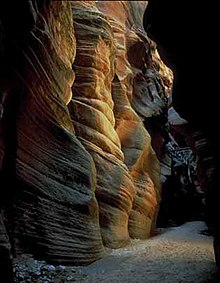Paria River
| Paria River | ||
|
The river in Paria Canyon at the mouth of the Buckskin Gulch |
||
| Data | ||
| Water code | US : 9211 | |
| location | Utah , Arizona ( USA ) | |
| River system | Colorado River | |
| Drain over | Colorado River → Gulf of California | |
| source |
Garfield County 37 ° 39 ′ 6 " N , 112 ° 4 ′ 43" W. |
|
| muzzle | in the Colorado River coordinates: 36 ° 51 '31 " N , 111 ° 36' 3" W 36 ° 51 '31 " N , 111 ° 36' 3" W.
|
|
| length | 153 km | |
|
Partial view of Paria Canyon |
||
The Paria River is a 153-kilometer tributary of the Colorado River in southern Utah and northern Arizona in the United States . It drains a rugged and dry area northwest of the Colorado and flows through impressive canyons as they are characteristic of the region.
The name comes from John D. Lee , a Mormon pioneer who was excommunicated from The Church of Jesus Christ of Latter-day Saints in 1871 for his involvement in the Mountain Meadows Massacre and who settled as penance on the Colorado River near the mouth of the Pariah River. He operated the ferry there, which gave the settlement Lees Ferry its name.
course
The origin of the Paria River lies in southern Utah, in Garfield County , north of the town of Tropic, located at Bryce Canyon National Park, on the edge of the Paunsaugunt Plateau , where several headwaters come together. From there it flows south-southwest through Kane County and the Grand Staircase-Escalante National Monument . Then he crossed the border to Arizona, where he dug his bed as Paria Canyon in the Paria Plateau. About 8 km southwest of Page and below the local Glen Canyon Dam , the Paria then flows into the Colorado. The last 20 miles of the river is in the Vermilion Cliffs National Monument , administered by the Bureau of Land Management .
Attractions
The Paria River is one of the region's most attractive destinations for canyon tourists. The Buckskin Gulch , a side canyon of Paria, is considered one of the longest and cut the deepest slot canyons of the United States. There are also a number of historical and geological sites worth seeing at the Paria. A little above the estuary is Lees Ferry , and further upstream there are a few ghost towns to visit. On the rock walls above the river, you can often see petroglyphs , i.e. rock carvings, which were carved here by the Indians . For flora and fauna , the river valley represents a unique, but also endangered ecosystem in which rare species have survived.
There are several natural stone arches in the canyon, notably the Wrather Arch , a sandstone arch formed by erosion , the largest of its kind in the United States outside of Utah. Before it was placed under protection, the pariah was regularly used as an ideal backdrop for western films, for example for Buffalo Bill (1944), Sergeants 3 (1962) and The Outlaw Josie Wales ( The Texan (1976)), the old film sets can still be visited today become.
natural reserve
The Paria Canyon was placed in 1984 as part of the Paria Canyon-Vermilion Cliffs Wilderness under the particularly strict nature protection of a wilderness area and in 2000 it was incorporated into the Vermillion Cliffs National Monument. Since then, access to the area has been strictly regulated. Day visitors can hike into the canyon from the south at Lee's Ferry or one of the two entrances to the canyons on the north side. For longer trekking tours, such as the five-day crossing of Buckskin Gulch and Paria Canyon, only a maximum of 20 people per day are allowed.
Weblinks (English)
- Paria River in the United States Geological Survey's Geographic Names Information System
- Paria Canyon-Vermilion Cliffs Wilderness
- AmericanSouthwest.net: Paria River
- Paria River Natural History Association



